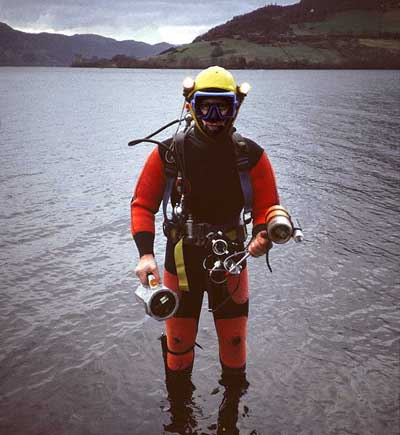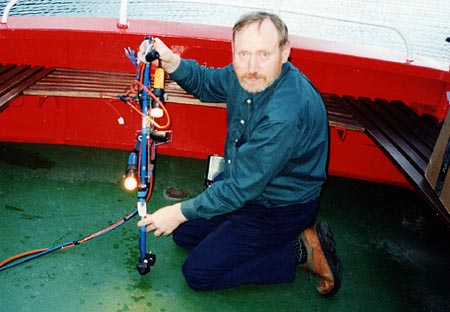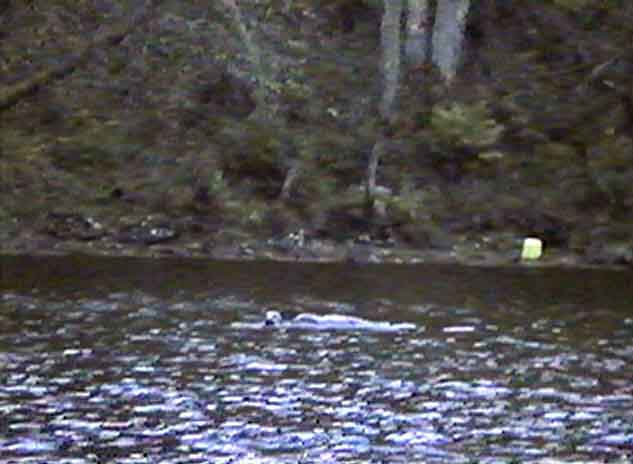Underwater Research - A Picture Gallery
snapshots of attempts to find out more...
George Edwards and Richard Carter with hydrophone equipment on board "Nessie Hunter" 1998. Dick Raynor was also there...in the leaking 2 metre inflatable boat, taking the picture! More about hydrophones?

Dick Raynor going in to Urquhart Bay to photograph "Gargoyles", 1987. This was the original way of getting "hands on", or rather "head under" experience in Loch Ness. Diving requires training and some fairly expensive equipment, but for some tasks there is no alternative. There are many places in Scotland where it is a very pleasant experience, but Loch Ness is not among them. I find that modern underwater television is definitely preferable for general observation purposes as it is silent in operation, safe and relatively inexpensive. ( Never one to throw anything away, those two lamps on my helmet are now used in the 100 metre camera rig below!).

Copyright © 2001 Dick Raynor.All Rights reserved.
2001 version: Camera rig with 2x 20 watt lamps and sonar
Submarines and ROVs
Submarines have been brought here on several occasions, as have ROVs, and more will be added to this section. In the meantime, please click on the link to see some pictures and find out a little more. Also, check out Dan Taylor's "Nessa" site to see how things are progressing there. The author has been down in Loch Ness in subs on several occasions, and also worked for several years as a remotely controlled vehicle pilot. The underwater cameras already in use have obtained interesting close-up sequences of eels and other fish, apparently undisturbed by the equipment's presence. As soon as suitable software has been obtained I will put the video here for you. (You thought that was a link, didn't you?...well. it soon will be!) While you are in this paragraph, I can tell you that I now have plans for a new underwater vehicle to be constructed over the next few months, utilising "Robot Wars" technology. Forget "Star Wars"...this will be 100% recycled, including the electrons!
More submarine pictures
NEWSHere is a still picture from a video I recorded in October 1999, in Urquhart Bay, Loch Ness. I invited your comments. Most people correctly identified it as a seal, probably a Grey Seal Halichoerus grypus. It may also be the first time this species has been photographed in Loch Ness. The smaller species, Phoca vitulina, was photographed in 1987 by Dr Gordon Williamson, and the scientific paper he wrote on the subject, "Seals in Loch Ness", is attached. Steve Feltham also videod a Harbour seal Phoca vitulina in the early 1990's.
Photo 1

August 1999
In late summer I tested a prototype video rig for the first time at depths down to 30 metres. The mooring weighing 100 kg was installed from the boat "Nessie Hunter", and the camera rig itself was lowered into position from the research vessel "TARDIS", seen at the left of the picture below, on 5th August. (I hope soon to purchase the stern half of the boat!) Powered from lead-acid batteries and an inverter, the equipment was operated and monitored by Rip Hepple from his camper van. The rig used low powered lighting, which gave a visual range of about 1.5 metres.
The Prototype Rig installed in August
1999, ashore for servicing.
Photo 2
I am planning to install one underwater camera on the bottom of the loch again in the coming weeks. The signal will be fed to a remote motion detector unit, and then to a remote recorder, producing recordings only when something moves in the picture. This will be complimented by other recording equipment, including lapse time video recording both on the surface and underwater. The framework carrying the underwater camera will again be made from "Dexion" material, similar to the prototype in the photograph.
As this site increases in complexity more photographs will be added showing what we are doing at the present time, as well as some interesting photos relevant to the database, showing unusual surface effects from various causes. If you have material you would like to contribute or comments to make, please contact me, Dick Raynor, at dratdickraynordotcodotuk
Update 25th January 2000Thank you to everyone who has emailed me with advice, ideas, offers of support and wishes to take part in the investigation. It now seems that it will be possible for self-reliant and slightly hardy individuals to take part in this work. More on this later.
First Surface Monitoring Camera Operational
I now have a colour tv camera monitoring the surface of the loch, with a continuous lapse-time recording being made. Any interesting frames will be posted here for all to see, and copies of the master tapes will eventually be available for supporters to purchase. Recordings are being made at 1/120th of normal speed, so a 3-hour tape covers a 360 hour period - 15 days.Underwater Rig nearing completion.
I know, it should have been installed three weeks ago, but the camera, with improved lights, was tested down to 40 metres on 20th January. One reason for the delay - and there were others- is the addition of sound recording equipment to the system. This had been planned as a later enhancement, but is now being incorporated right from the start. One interesting observation was that the eels, a reliable feature of the rivermouth area in Urquhart Bay during the summer months, were not seen at all in over an hour of bottom time in that area.Update 22nd February 2000
Two camera units are now in final stages of assembly. The first is the fixed mode underwater tv with "event only" recording and sound facility. The 2 x 20 watt lamp units and sound transducer / launch amplifier are now potted and simply awaiting connection to their cables. I am now experimenting with pan and tilt systems for it.
The second unit is the exciting Deep Eye(D -Pi) unit, which has been designed to withstand the pressure at 1000 feet. It will be fitted with 300 metres of cable and a single 20 watt lamp, and it is intended to be lowered to areas of special interest. In shallow water ( less than 50 metres) it is fairly easy to manipulate a camera by moving the boat around. In deep water there is much more drag on the (necessarily longer) cables, and the camera can be many ten of metres away from the "plumb" position, directly below the support boat. To try to overcome these problems, I am presently designing a miniature thruster system to help position the camera.
Finally, there are rumours of several different "expeditions" to Loch Ness this year. To someone who grew up on stories of Scott and Shackleton, a ten or twenty minute drive from Inverness town centre hardly deserves the term "expedition", whether applied to my project or other ones. It would be useful if investigators co-operated more to avoid unnecessary repetition of work, but in these days of exclusive media deals it may be unrealistic to expect Science to be always in the driving seat. As in previous years, those engaged in serious work will co-operate with local researchers, and those who are not, will not.
I am not competing with anyone, and my underwater tv equipment, lights, boats and logistical support is available for hire by any visiting researchers. I look forward to meeting them in the coming months.
Update 20th March 2000
Fixed underwater camera station launched!
Update 27th March 2000
Videos launched! for LNI 2000 TV Camera
June 18th 2000
Copyright 2000 Dick Raynor
This rather grainy still frame may not look like much of a technical leap forward, but it is just one frame of over 90,000 recorded on 18th June on the Drumnadrochit based vessel "Deepscan" as we lowered the amazingly tough System Q camera to a depth of over 300 feet in Loch Ness. What had been planned as a test for the modified halogen lights was changed into a progressively harsh test for lights and camera combined.Bedrock below Urquhart Castle Tower Previously we had considered 50 metres (165 feet) an extreme test of the equipment, but on this dive we decided to test test the equipment to its limits. The pair of 12 volt, 20 watt halogen lamps on 100 metres of cable illuminated the scene, and the sonar display showed the bottom falling rapidly away beneath us as we slowly tracked out from the ruined Castle tower.
The analogue video signal was fed directly into a Sony digital camcorder, and an excellent record was obtained of the entire dive. We lost visual contact with the bottom at about 95 metres after we had paid out all the cable, nd the boat drifted into deeper water .
Copyright Dick Raynor 2000 Prototype towed camera June 2000.
OK, it doesn't look like a submarine; its not even yellow, but then the first Lunar Landing Module didn't look much like a space-ship. This device can go where no submarine would dare, and our view of the underwater world is probably better as we can approach to within centimetres of any object for a close inspection, and we do it in complete silence. With a 100 metre cable bundle that will fit in a normal laundry basket, this is an extremely portable outfit that can be taken anywhere in a suitcase and used from the smallest of boats. The camera is fitted at the very bottom of the grey slotted steel angle, and the twin 20 watt halogen lights are on swivelling brackets about one foot - 30 cm - higher up. The orange cable supplies the power to the lights, while the camera power and video signal are contained in the black cable. These two are taped together with 100 m of polypropylene rope for added strength. So far it bears a striking resemblance to the August 1999 rig used off Abriachan Pier. A blue plastic rod one metre long forms the backbone of the rig, and at the top of it there is clamped a vane which can be attached at various angles to cause the camera to point in the required direction as it is pulled through the water. This is usually a straight-ahead setting except when traversing a long slope, where it is useful to have the camera looking slightly towards the upward side of the slope. In case anyone cares to question the hydrodynamic qualities of the Dexion angle, I can set their minds at rest. It simply doesn't have any.
The next step
The custom encapsulated camera on 1000 feet (300 metres) of cable is now ready for depth testing. The lamp unit was successfully tested to 230 metres earlier on 18th June 2000 from the new "Nessie Hunter". Within a week, I expect that no part of Loch Ness will be beyond the reach of our television cameras. From then on, we can explore anywhere we choose! We have our own "submersible" which can silently explore anywhere in Loch Ness and record the images in high quality digital format.
More stills from the deep dive
In all of these pictures, which are only still frames from the video recording, the camera is looking quite steeply down the slope ahead of it. I hope to be able to show some video clips on the site soon, but anyone wanting to have their own copy of the videotape can buy one from me. This is a mutually beneficial arrangement which will help to pay for the exploration.
News at 20th June 2000Seals back in Loch Ness
Seals have again been reported in Urquhart Bay during the week ending 18th June. At this time of year water birds like mergansers and divers are taking their new broods out onto the water, and the highly mobile groups frequently confuse inexperienced observers, generating "monster sightings" in the process. The additional reported presence of seals will create a higher than normal probablility of a "sighting" until the seals are shot by the Ness District Fishery Board.
Pumas blamed for livestock kills.
There has been a recent upsurge in livestock losses attributed to big cats, believed to be pumas, in the Inverness area. One was nearly hit crossing a road near Drumnadrochit. Campers be warned...
Black-Throated Divers seen.
I have seen a pair of Black-Throated Divers both in Dores Bay and near Urquhart Castle over the past two weeks. They are magnficent birds, looking very similar to the object in the Lake Champlain "Mansi" photograph when photographed from the correct angle. I only just failed to get some video of them on 18th June.
Recently added pages in Database
Two new pages added on 24th June 2000, one is about dolphins in 1934, and the other is set in 1936, containing material not published before, including sketches of an animal on a beach made by Alastair Dallas, a key figure in the McRae story..